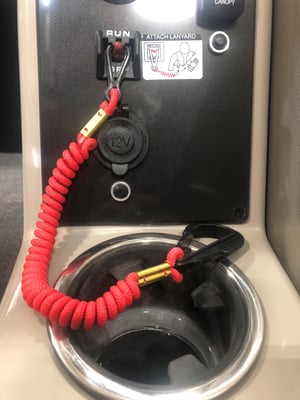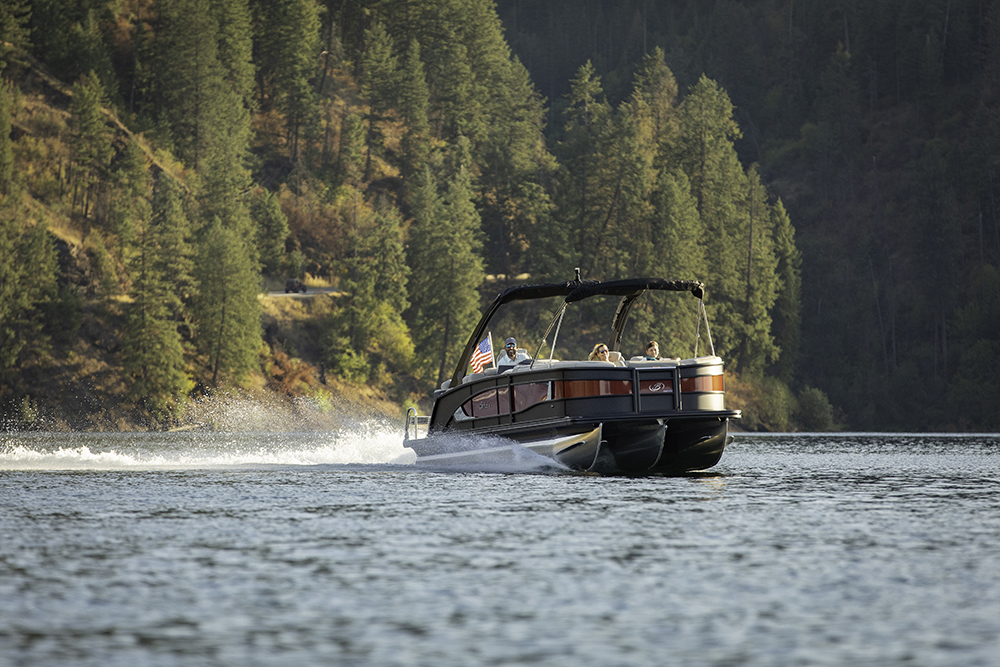Engine Cut-Off Switch: Info Boaters Need to Know
When it comes to boats big or small, there are lots of buttons and switches you need to understand how to operate. Each has a purpose and sometimes, it can be overwhelming trying to figure out what everything does.
No matter what type of boat you own or rent, these components will vary based on the brand and the type of boat. Most controls will be on or near the helm and are typically labeled with their function. There’s one constant that you will find on nearly any recreational vessel, however.
Have you ever been on a boat and wondered what the red lanyard near the ignition is for? That item has a few different names which include emergency cut-off switch, safety lanyard, engine cut-off switch, and kill switch, just to name a few.
This is one of the top safety features on any boat and oftentimes doubles as the ignition on a personal watercraft. In short, I'm going to call it the kill switch in this article and rundown all the reasons you should be aware of the importance of this component if you plan to operate watercraft of any type.
What is the Kill Switch?
The kill switch, or engine cut-off switch, is in place to stop the engine during emergencies. Its sole purpose is to keep the motor from running which stops the propeller from turning.
The kill switch is located in the vicinity of the ignition in most recreational boats and typically has an engine cutoff link attached to it. When the switch is in the on position, the boat will start and run. If it’s in the off position, the engine will not run or start at all.
The engine cutoff link is typically a red coiled lanyard that’s attached to the kill switch intended to flip the switch off in emergency situations. This happens only if the driver of the boat or PWC wears the lanyard as they’re supposed to.
As of April 1, 2021, a new federal law was imposed that requires the operator of a motorized recreational vessel with three or more horsepower that is less than 26 feet to attach the kill switch lanyard to their person while underway. As the driver, you are supposed to attach the lanyard by clipping it to your lifejacket or clothing.

Why Should You Wear the Lanyard?
As I mentioned, the lanyard that’s attached to the switch will flip the switch if it’s pulled hard enough. The reason for this is, that if the driver is wearing the lanyard while underway and is thrown from the helm, the lanyard will pull the switch, turning it off and killing the engine.
According to the USCG website, a typical three-blade propeller running at 3,200 rpm can inflict 160 impacts in one second. That’s why, being able to kill the engine in this type of emergency can save lives and at the very least, can save your boat from extensive damage.
If the lanyard is not worn and the driver is thrown from the wheel, the boat would still be underway without a driver. This type of situation could lead to the boat going rogue, hitting nearby boats, or worse.
As I mentioned above, it can double as the ignition for PWCs. What I mean by that is, if you’re driving a WaveRunner or jet ski, most of the time the key will be attached to a lanyard. The driver is intended to attach the lanyard to their person, this way if they’re thrown off of the WaveRunner, the key will come out of the ignition and kill the engine.
I’ve been in this situation many times as we had WaveRunners growing up on the lake. Falling off is quite common especially if you are on a choppy body of water. The key acting as a kill switch will save you a long swim once you fall off because the engine will shut down immediately slowing the PWC to a stop.
This can also keep you and nearby boaters safe as the PWC will not be cruising across the water without a driver. The safety lanyard on any recreational watercraft is intended to be worn and depending on the size of your boat, it is the law.
So when is it ok to take the lanyard off of your person? If the boat is idling or you’re docking the boat, you’re not required by law to have the safety lanyard attached. If the boat is underway fast enough to be on plane and beyond, you must have the safety lanyard attached.
To be safe, if you’re on a vessel that has a kill switch, I recommend attaching it once you’re in the captain’s chair before you pull away from the dock. This way it’s on before you accelerate and get the boat on plane.
Things to Consider
Manufacturers were required by law to include a kill switch on any motorized boat that is under 26 feet and puts out three or more horsepower starting on Jan 1, 2020. That said, not all recreational boats that meet those requirements and were built before that date have the switch included.
If your boat falls into that category and was built before January 2020, you are not required to add the kill switch to the boat. If your boat was built on or after that date and doesn’t have one, the owner of the boat is required to install and maintain the switch themselves.
From my many years on the water, I have been on all different types of watercraft. Even the boats and PWCs I have been on that were built before 2020 always had a kill switch with a lanyard included. It’s more typical than not that boat builders were adding this feature to the boats long before it was required by law.
There are only two exemptions when it comes to having a kill switch on board a recreational vessel. If your main helm is in an enclosed cabin, the law doesn’t require a kill switch. The other exemption is for those recreational boats over 26 feet that are not required to have one.
That said, my current boat is just over 26 feet and it has one installed from the manufacturer. As I mentioned, most will have this feature on board no matter what. That being said, you should be aware that although the main purpose of this switch is for safety, it can make or break your day on the water.
I mentioned before that if the switch is in the off position, the boat will not start or run. Because of that, there’s a good chance you could think there is something wrong with your boat. There’s a large percentage of service calls that dealers get each boat season because someone’s switch got bumped into the off position.
I always recommend checking the switch first thing if your engine is not turning over. Having the switch flipped off even slightly will kill the motor and keep it from starting. Keep this in mind if you’re underway and have the lanyard attached to your person.
If you move too far from the helm or say your captain’s chair swivels and the lanyard is pulled hard, the switch is likely to be turned off. Always check the kill switch first if your boat seems to be having issues like turning off abruptly or not starting.
Safety First
Safety should always be a priority when it comes to boating on any body of water and on any type of vessel. The kill switch on a boat is in place to keep the boat from running without a captain in the driver’s seat. From personal experience, this is a really big deal.
A handful of years ago, a neighbor was boating through the channel when their throttle glitched and the boat took off full speed leaving the captain unable to reach the kill switch. The boat ran up on shore because the driver wasn’t wearing the safety lanyard and the kill switch was never engaged.
Luckily they lived and no one else was harmed, but had he been wearing the lanyard, the boat would have never jumped the seawall and made it up on land. This is just one example of how critical a kill switch is.
Being able to stop the engine in a dangerous situation also stops the propulsion of the propeller. That’s hugely important if you or your passengers are thrown from the boat or there are swimmers nearby.
If your boat has a kill switch and safety lanyard, you should consider attaching it before taking off. Depending on your boat, it could be the law, but no matter what, it’s always common sense. If you need to stop the boat abruptly and you’re not wearing the lanyard, make yourself familiar with how to access and engage the kill switch itself.
For a visual on how to properly secure the safety lanyard to yourself and keep the switch in the on position while underway, check out this video by Mercury Marine.



